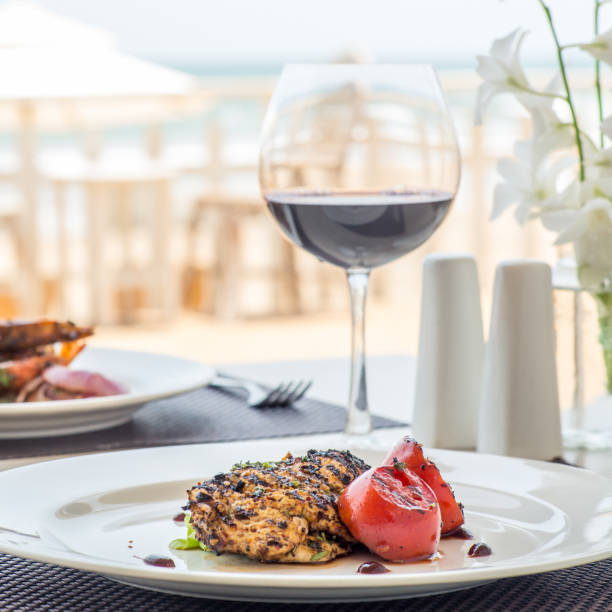Grapes are not merely small, juicy orbs that delight our taste buds; they are the building blocks of one of the world’s oldest and most revered beverages – wine. However, the world of grapes extends far beyond the confines of the vineyard, encompassing a diverse array of flavors, textures, and aromas. In this exploration of grape profiles, we will delve into the intricate world of grape varieties, each contributing its unique characteristics to the rich tapestry of wine and culinary experiences.
Cabernet Sauvignon – The Aristocrat of Red Grapes:
Let’s start our journey with the regal Cabernet Sauvignon. Often referred to as the “king of red grapes,” Cabernet Sauvignon has gained global acclaim for its deep, intense flavors and remarkable aging potential. Originating from the Bordeaux region in France, this grape variety has found a home in vineyards worldwide.
Cabernet Sauvignon grapes are small and thick-skinned, imparting a robust tannic structure to the wines. The flavors range from blackcurrant and plum to subtle hints of green bell pepper and cedar. The wine’s aging process softens its edges, revealing complex layers of flavor, making it a favorite among wine enthusiasts who appreciate bold, structured reds.
Chardonnay – The Versatile White Wonder:
On the white grape front, Chardonnay stands out as one of the most versatile and widely planted varieties. Originating from the Burgundy region in France, Chardonnay has become a global icon, showcasing an incredible range of styles depending on the winemaking techniques employed.
Chardonnay grapes are relatively neutral in flavor, allowing winemakers to shape the final product to suit their preferences. Unoaked Chardonnays often exhibit crisp acidity and flavors of green apple, citrus, and minerality. In contrast, oaked versions display a creamy texture with notes of vanilla, butter, and ripe tropical fruits. This adaptability makes Chardonnay an excellent canvas for winemakers to express their creativity and for consumers to find a style that suits their palate.
Pinot Noir – The Temperamental Virtuoso:
Pinot Noir, often referred to as the “heartbreak grape,” is notoriously finicky to cultivate but rewards winemakers with wines of unparalleled elegance. Originating from the Burgundy region in France, Pinot Noir has captured the hearts of wine enthusiasts for its delicate nature and nuanced flavor profile.
The thin-skinned Pinot Noir grape yields wines that are light to medium-bodied, with flavors ranging from red berries and cherries to earthy and floral notes. The grape’s sensitivity to terroir, climate, and winemaking practices means that Pinot Noir expresses itself uniquely in each region, showcasing the profound impact of the vineyard on the final product. Burgundy, Oregon, and New Zealand’s Central Otago are renowned for producing exceptional Pinot Noir wines.
Sauvignon Blanc – The Crisp and Zesty White:
Sauvignon Blanc is celebrated for its vibrant acidity and unmistakable aromatics. Originating from the Bordeaux and Loire Valley regions in France, this white grape has found success in a variety of climates worldwide, each contributing its own twist to the classic profile.
Sauvignon Blanc is known for its herbaceous and citrusy character, often accompanied by notes of green bell pepper, passion fruit, and gooseberry. New Zealand’s Marlborough region has become synonymous with the grape, producing Sauvignon Blanc that is particularly expressive, featuring intense tropical fruit flavors and a zesty acidity that dances on the palate.
Merlot – The Approachable Red:
Merlot, often considered Cabernet Sauvignon’s softer counterpart, offers a more approachable and fruit-forward option for red wine enthusiasts. Originating from the Bordeaux region, Merlot has spread its roots globally, adapting to various climates and winemaking styles.
Merlot grapes are plump and juicy, resulting in wines that are medium to full-bodied with velvety tannins. Flavors range from ripe red fruits like plum and cherry to herbal and chocolate notes. Merlot’s versatility makes it a popular choice for blending, contributing a smooth texture and roundness to many Bordeaux-style blends.
Syrah/Shiraz – The Bold and Spicy Red:
Syrah, known as Shiraz in Australia, is a bold and robust red grape that thrives in warm climates. Originating from the Rhône Valley in France, Syrah has become a global favorite, showcasing its adaptability to diverse terroirs.
Syrah/Shiraz wines are characterized by their dark color, full body, and flavors of blackberries, black pepper, and smoky notes. In the Northern Rhône, Syrah produces wines with a more restrained and peppery character, while Australian Shiraz tends to be more fruit-forward and opulent. This grape’s expressive nature allows winemakers to craft wines ranging from everyday sippers to age-worthy collectibles.
Zinfandel – The American Maverick:
Zinfandel, a quintessentially American grape, has a storied history and an eclectic flavor profile. Though its origins were long debated, DNA analysis eventually traced Zinfandel back to Croatia, where it is known as Crljenak Kaštelanski. Today, Zinfandel is synonymous with California, where it thrives in the warm climate.
Zinfandel wines are bold, fruit-driven, and often high in alcohol. Flavors include dark berries, black pepper, and sometimes a hint of spiciness. Zinfandel’s versatility allows for a wide range of styles, from easy-drinking, jammy reds to more complex, age-worthy expressions.
Conclusion:
The world of grape profiles is a vast and fascinating realm, offering a diverse array of flavors and experiences. From the aristocratic Cabernet Sauvignon to the versatile Chardonnay, the temperamental Pinot Noir to the zesty Sauvignon Blanc, and the bold Syrah/Shiraz to the American maverick Zinfandel – each grape variety contributes its unique characteristics to the world of wine.
As you explore the intricate world of grape profiles, consider the impact of terroir, climate, and winemaking techniques on the final product. Whether you prefer the bold and structured reds or the crisp and refreshing whites, the world of grapes invites you to embark on a journey of discovery, savoring the nuances that make each variety a distinctive expression of nature’s bounty. So, the next time you enjoy a glass of wine, take a moment to appreciate the grape behind the label – a small, yet powerful, fruit that has shaped the world of viticulture and enology for centuries.



